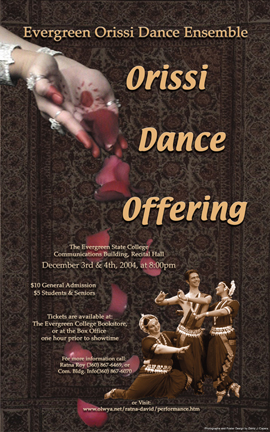Orissi Dance Offering
 Artistic
Director: Dr. Ratna Roy
Artistic
Director: Dr. Ratna Roy
PROGRAM NOTES
Namami: (choreography: Padmabibhushan Guru Kelu Charan Mohapatra). Raga: Hamsadhvani; Tala: Ektali. Dancers: Laurie Fox; Jessie Hirsch; Ankita Mishra; Marissa Betz-Zall. The dance opens with bhumi pranam (connecting with Mother Earth). Then it goes on to describe Lord Ganesha, the elephant-headed large bodied one, remover of obstacles, Lord of Dance, son of Uma and Shiva, seated under a tree, bestower of knowledge. The dance ends with sabha pranam (asking the blessings of all in the audience).
Shiva Mangalacharana: (choreography: Guru Deba Prasad Das). Raga: Kalyan; Tala: Ektali. Dancers: Frank Casey & Jamie Lynn Colley. The dance begins with “Mancha Pravesh” (entrance on to stage). After the bhumi pranam, Lord Shiva is described: From whose matted locks emanates the beautiful Ganges River, whose left side is feminine inhabited by the soul of Gauri, who was loved by Narayana, who decimated Madana when interrupted in his meditations. Then comes the Shiva Sabda, the tandava of Shiva, a specialty of Guru Deba Prasad Das’ choreography. Finally the sabha pranam is in the Mahari style of Guru Pankaj Charan Das.
Arati Sthayi: (choreography: Padmashri Guru Pankaj Charan Das & Ratna Roy). Raga: Kalyan; Tala: Ektali. Dancers: Jaya Ghosh & Aimee Machiels. The foundation dance in the Mahari style, Sthayi is an elaboration of the basic positions and bhangis of Orissi dance, culminating with the orchestra: veena (stringed instrument), flute, mardala (drum), and cymbals. The plate with candles is specifically a Mahari tradition from the Telengana Maharis at the Jagannatha Temple.
Arabhi Pallavi: (choreography: Padmabibhushan Guru Kelu Charan Mohapatra). Raga: Arabhi. Tala: Ektali. Dancers: Frank Petty III & Priyanka Ganguly-Wilkins. The most exquisite iten in Orissi, a pallavi is the flowering dance. It is the flowering of the music, the drum, and the dancers’ bodies.
Yahi Madhava: (choreography: Padmashri Guru Pankaj Charan Das). Raga: Bhairavi; Tala: Ektali. Dancer: Jamie Lynn Colley. The song was written by the great poet, Jayadeva. This ashtapadi begins with Radha lighting the lamp, making a garland, betels, sandal paste, and then the bed, as she waits for Lord Krishna. Radha spends a sleepless night waiting for Lord Krishna. When Krishna arrives the next morning he has tell-tale marks of a night of love-making. Angry and hurt, Radha asks him to leave her house. Throughout the song, the refrain is: “Go away Madhava, Go away Keshava. Don’t tell me your lies,” as Radha goes through tumultuous emotions of anger, pain, love, disdain, mockery, and finally spirituality—the hallmark of the Mahari style of Padmashri Guru Pankaj Charan Das.
Moksha: (choreography: Guru Deba Prasad Das). Dancer: Cristina Maher-Rout. Mardala: Nirmal Rout. The final release, the joining of the soul and the body with the Ultimate through rhythm.
INTERMISSION
Nava Durga: (choreography: Padmashri Guru Pankaj Charan Das). Raga: Bhairava. Tala: Jati. Dancer: Sitara Thobani. The dance begins with bhumi pranam and continues on to depict the Goddess Durga who fought her battles against the egotistical Sumbha, Nisumbha, and Andhaka. She is our Mother who protects us. She also fought Mahisasura, the embodiment of male ego, and speared him dead. She who has nine forms, our Mother, is embodied in the Female. The dance ends with a Sabha Pranam.
Batu: (choreography: Padmabibhushan Guru Kelu Charan Mohapatra). Raga: Kalyan. Tali: Ektali. Frank Casey, Kristina Ching, Jamie Lynn Colley, Ruth Nelson-Moore, & Aimee Machiels. Batu is the equivalent of Sthayi in the Gotipua style. This choreography has been conceived as the awakening of the sculptures at the Konarak Temple with the full moon rising in the sky.
Mandodari: (choreography: Padmashri Guru Pankaj Charan Das). Raga: Misra. Tala: Misra. Dancer: Ratna Roy. The script was written by Kishore Kabi Shyam Sundar Das, based on the Oriya Dharma Purana. The dance opens with the introduction of Ravana and Mandodari: the story of the hermit, Mandar, who incurs the wrath of the Earth for keeping his milk to himself. She sends Mani naga, the serpent, to poison the milk. Realizing the consequences, the frog at the hermitage jumps into the milk and kills herself to save the hermit. The hermit, on his return, curses the frog for its gluttony. This curse reversed a previous curse, and the frog turns into the beautiful maiden, Mandodari. Mandodari is coveted by both Bali and Ravana, is split in two and revived as “Mandodari.” The story moves on to the war scene of devastation—a scene that affects Mandodari. The next sequence: the lovemaking of Mandodari and her husband culminates in Ravana’s impatience, Mandodari’s pleadings to return Sita, and Ravana’s memory of the kidnapping. Description of Ravana: Victorious, accomplished, with a visage like Shiva’s, destroyer of all enemies, the Indra (King of the Heavens) of Lanka, Ravana is invincible, the conqueror of the three worlds. This powerful Ravana beseeches his wife to keep his throne occupied since he did what he had to in order to attain Brahma, eternal bliss. He is now the sworn enemy of Rama. Mandodari prepares her husband for his final battle, the battle with Rama in which Ravana is killed. Out of the ashes of Lanka, the death of Ravana, emerges Lanka Rani (The Queen of Lanka), the Auspicious woman, the strategist who makes a truce with Rama in her attempt to rebuild the empire. She marries Bibhisana to accomplish her mission.
Moksha: (choreography: Padmabibhushan Guru Kelu Charan Mohapatra). Dancers: Frank Petty III & Priyanka Ganguly-Wilkins.
Om Shantih: Curtain call.
________________________________
For more information send e-mail inquiries to
ratna-david@olywa.net